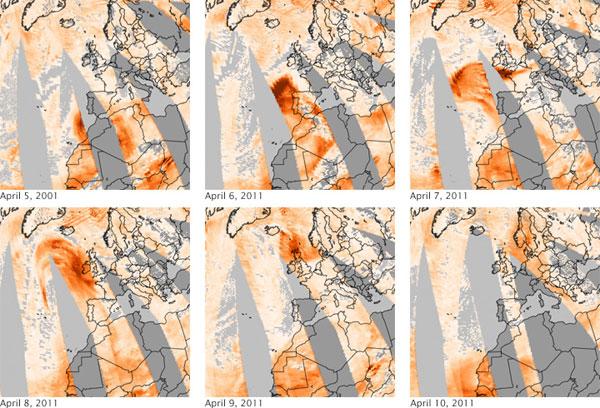Huge Sahara Dust Plume Blows from Africa to Scandinavia


This month, dust from a Saharan sand storm blew several thousand kilometers across the North Atlantic and Europe, and was tracked by instruments aboard NASA's Aura satellite.
Dust is one of the most abundant aerosols in the atmosphere . An aerosol is a tiny solid or liquid particle suspended in the atmosphere. Aerosols have important impacts on weather, climate , and human health. Dust can fertilize the ocean for plankton and seed the sky for cloud formation.
Mineral dust becomes airborne as winds sweep it up as they blow across deserts and beaches, distributing it all over the world.
In this series of images from Aura's Ozone Monitoring Instrument (OMI), the aerosol concentration of the huge dust plume is measured. Aerosol concentrations in the air are represented by a quantity known as the aerosol index, with the highest concentrations in deep red and the lowest in light yellow. The gray areas represent clouds or areas where no reliable OMI data were available.
The aerosol index is calculated based on how particles absorb and scatter light. Specifically, the index is a measurement of the difference between the amount of ultraviolet (UV) light the dust-filled atmosphere scatters back to the satellite compared to the amount of UV the atmosphere would scatter back if skies were totally clear.
OMI spied the Saharan dust on April 5, 2011, as it was blowing over Morocco and Algeria (top left image). By the next day (top middle), the plume drifted north past the coast of Portugal . The storm veers west, then north and east on April 7 9, before arriving over Scandinavia on April 10 (bottom right).
Though Saharan dust blows through Europe several times a year, "the scale of this cloud and the amount of dust is somewhat unusual, including the amount of dust transported to the northern and eastern parts of Europe," atmospheric scientist Colin Seftor, based at NASA's Goddard Space Flight Center in Greenbelt, Md., said in a statement. "I've seen events of this magnitude maybe once every couple of years."
Get the world’s most fascinating discoveries delivered straight to your inbox.
"Dust clouds can travel long distances under the right conditions," Seftor added. "The typical pathway for the transport of Saharan dust clouds is westward, all the way across the Atlantic to the Americas. In fact, Miami often suffers from poor air quality due to this dust. And we've tracked dust clouds from the Gobi desert being transported all the way across the Pacific as far the East Coast of the United States."



